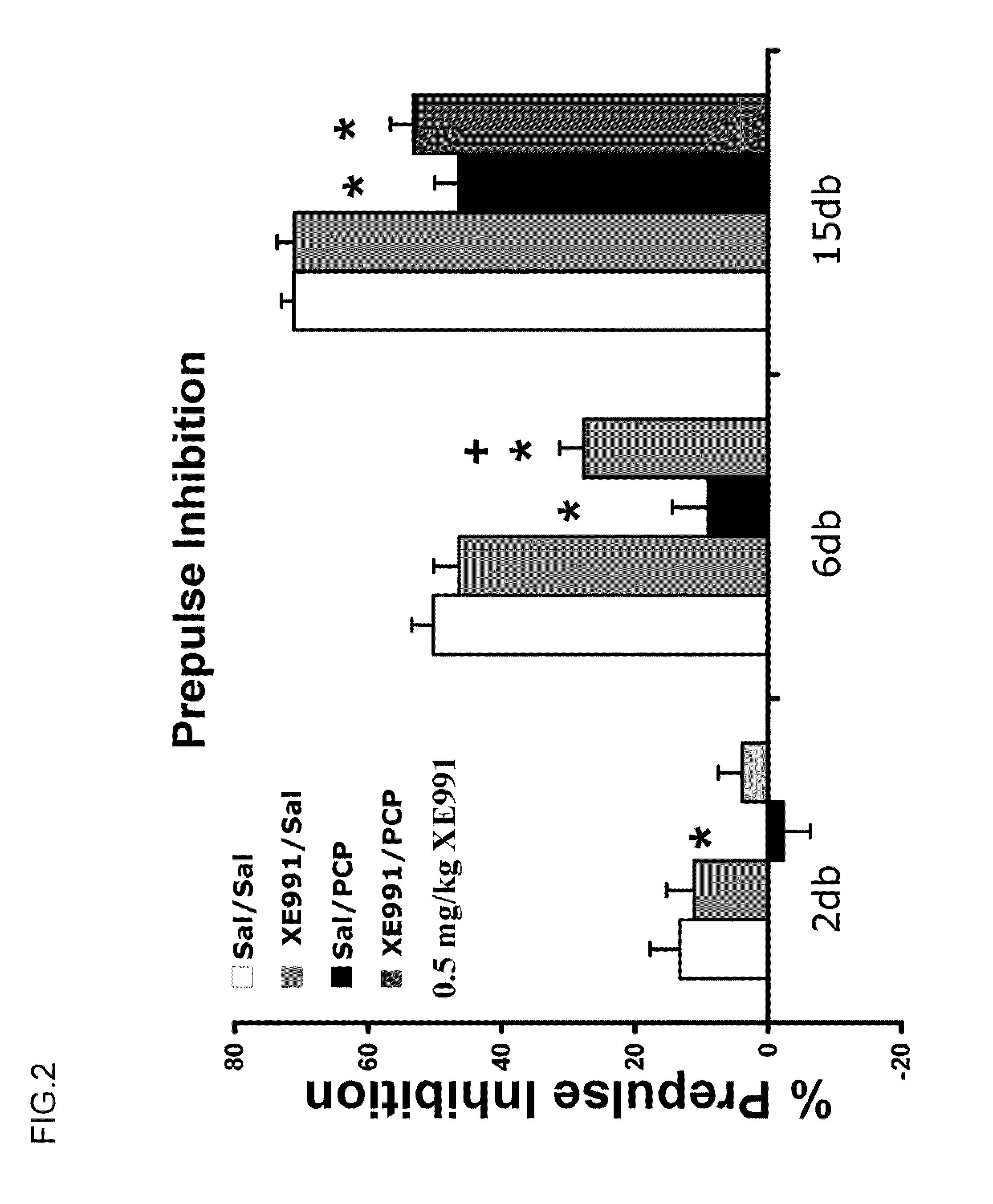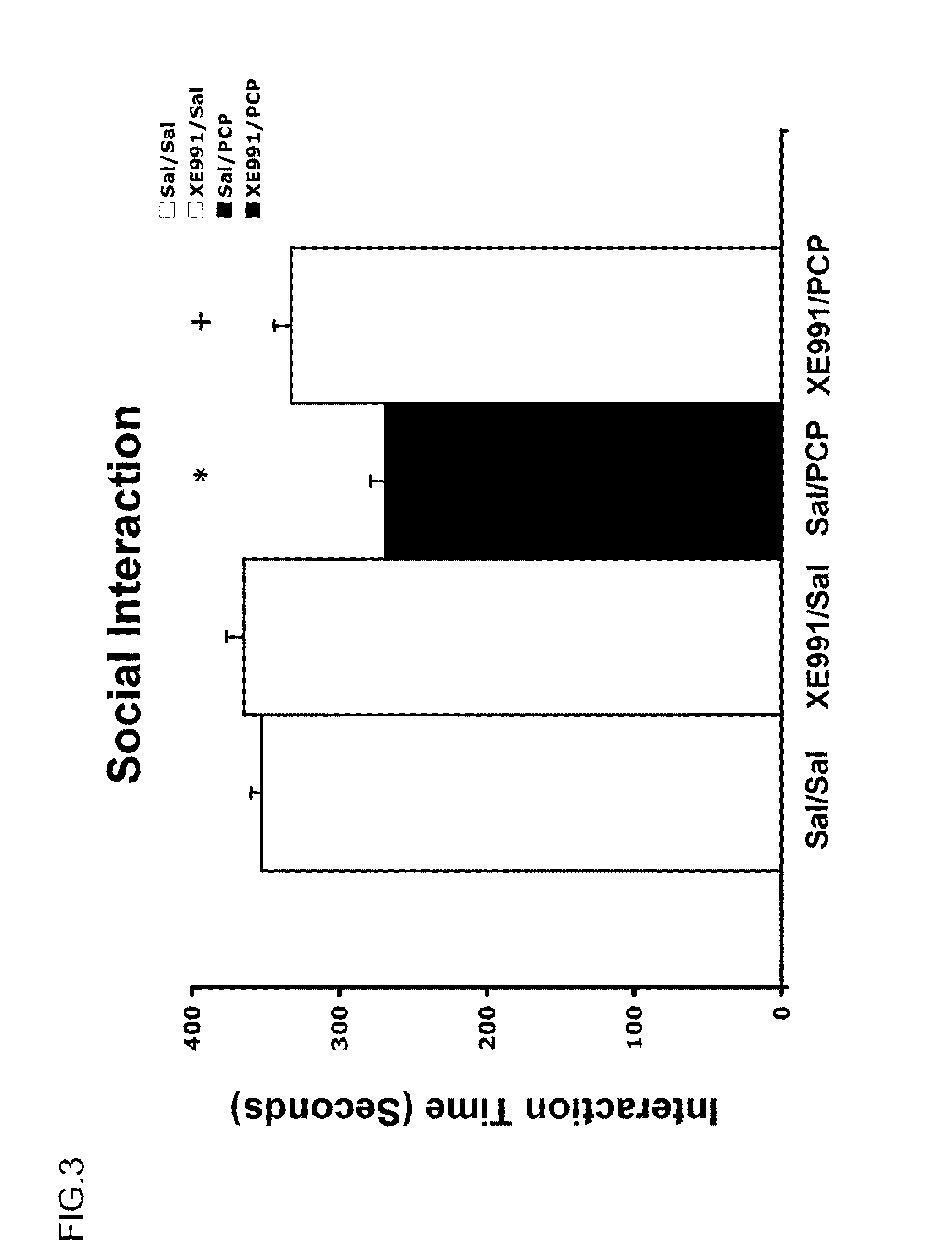Modulation of KCNQ Potassium Channel Activity for Treatment of Psychiatric Disorders and the Symptoms Thereof
a potassium channel and kcnq technology, applied in the direction of drug compositions, biocide, heterocyclic compound active ingredients, etc., can solve the problems of untreated adequately and suggest a previously unrecognized use, and achieve the effect of inhibiting kcnq (kv7) potassium channel activity and modulating kcnq
Active Publication Date: 2010-12-09
MARQUETTE UNIVERSITY
View PDF4 Cites 0 Cited by
- Summary
- Abstract
- Description
- Claims
- Application Information
AI Technical Summary
Benefits of technology
[0009]In some embodiments, the compound inhibits KCNQ (Kv7) potassium channel activity. For example, the compound may block or close a KCNQ (Kv7) potassium channel (e.g., as determined by observing a decrease in flow of potassium ions through the channel). In some embodiments of the methods, the compound is administered in order to deliver an effective concentration of the compound for closing the KCNQ (Kv7) potassium channel (e.g., in neurological tissue).
[0010]The compositions and methods are effective for treating a patient having a psychiatric disorder or symptoms thereof. In some embodiments, the patient has schizophrenia and the disclosed compositions and methods are effective for treating one or more negative symptoms of schizophrenia in the patient. Negative symptoms include, but are not limited to, flat effect, lack of motivation, anhedonia, diminished speech, social withdrawal, lack of energy, and apathy.
[0011]In some embodiments, the compositions include and the methods utilize compounds that inhibit KCNQ (Kv7) potassium channel activity. Suitable inhibitors of KCNQ (Kv7) potassium channel activity may include Linopirdine (3,3-bis(4-pyridinylmethyl)-1-phenylindolin-2-one), XE991 (10,10-bis(4-pyridinylmethyl)-9(101-1)-anthracenone), DMP543 (10,10-bis(2-fluoro-4-pyridinylmethyl)-9(10H)-anthracenone), and other compounds, analogs, or derivatives as disclosed herein.
[0012]The compositions may include and the methods may utilize the inhibitor of KCNQ (Kv7) potassium channel activity as a single active ingredient, or the compositions may include and the methods may utilize a second compound as an active ingredient. For example, the compositions may include and the methods may utilize a first active ingredient that treats a negative symptom of schizophrenia and a second active ingredient that treats a negative symptom or another type of symptom of schizophrenia (e.g., a positive symptom or a cognitive symptom of schizophrenia). In some embodiments, the methods include administering an effective amount of a second compound for treating a psychiatric disorder selected from a group selected from chlorpromazine, haloperidol, fluphenazine, promazine, clozapine, sertindole, amisulpride, zotepine, paliperidone, risperidone, aripiprazole, lamotrigine, quetiapine, perphenazine, flupenthixol, ziprasidone, olanzapine, lithium, and valproic acid. The second compound may be administered before, concurrently with, or after the compound that inhibits KCNQ (Kv7) potassium channel activity. For example, the second compound may be administered before the compound that inhibits KCNQ (Kv7) potassium channel activity, and the compound that inhibits KCNQ (Kv7) potassium channel activity may be administered to the patient after the patient becomes refractory to treatment with the second compound. In methods where the compound that inhibits KCNQ (Kv7) potassium channel activity and the second compound are administered concurrently, the two compounds may be formulated together as a single pharmaceutical composition and administered as a single pharmaceutical composition. Alternatively, the compound that inhibits KCNQ (Kv7) potassium channel activity and the second compound may be formulated as separate pharmaceutical compositions that are administered concurrently.
[0013]In further embodiments of the methods, the patient having a psychiatric disorder is a patient that is addicted to a psychostimulant such as cocaine or methamphetamine. The compound that modulates KCNQ (Kv7) potassium channel activity may include a compound that inhibits KCNQ (Kv7) potassium channel activity (e.g., Linopirdine, XE991, DMP543, and other compounds, analogs, or derivatives as disclosed herein). In some embodiments of the disclosed methods, the compound may be administered to the patient having an addiction in an effective amount for treating the addiction or a symptom thereof such as craving.
[0014]Also disclosed herein are methods for screening for compounds to treat psychiatric disorders associated with KCNQ potassium channel activity. For example, compounds that are identified as modulators of KCNQ potassium channel activity in vitro (e.g., as determined by measuring an increase or decrease in a potassium current through the channel when the compound is present) may be selected as candidate compounds for treating psychiatric disorders associated with KCNQ potassium channel activity. In another example, compounds that are capable of displacing a channel binding compound (optionally labeled with a fluorophore or an isotope) may be selected as candidate compounds for treating psychiatric disorders associated with KCNQ (Kv7) potassium channel activity.
Problems solved by technology
Furthermore, the data suggest a previously unrecognized use for existing drugs that operate as KCNQ channel closers.
The above mentioned impairments have been reported to occur in schizophrenia patients, and include the negative symptoms and cognitive deficits of schizophrenia, which are currently not treated adequately by existing medications.
Method used
the structure of the environmentally friendly knitted fabric provided by the present invention; figure 2 Flow chart of the yarn wrapping machine for environmentally friendly knitted fabrics and storage devices; image 3 Is the parameter map of the yarn covering machine
View moreImage
Smart Image Click on the blue labels to locate them in the text.
Smart ImageViewing Examples
Examples
Experimental program
Comparison scheme
Effect test
embodiment 1
[0089]A method for treating a negative symptom of a psychiatric disorder in a patient in need thereof comprising administering an effective amount of a compound that inhibits KCNQ (Kv7) potassium channel activity.
embodiment 2
[0090]The method of embodiment 1, wherein the compound blocks or closes the KCNQ (Kv7) potassium channel or reduces channel function.
embodiment 3
[0091]The method of embodiment 1 or 2, wherein the patient has schizophrenia.
the structure of the environmentally friendly knitted fabric provided by the present invention; figure 2 Flow chart of the yarn wrapping machine for environmentally friendly knitted fabrics and storage devices; image 3 Is the parameter map of the yarn covering machine
Login to View More PUM
| Property | Measurement | Unit |
|---|---|---|
| volume | aaaaa | aaaaa |
| volume | aaaaa | aaaaa |
| disorder | aaaaa | aaaaa |
Login to View More
Abstract
Disclosed herein are compositions and methods for treating a psychiatric disorder or symptoms thereof in a patient. The compositions comprise a compound that modulates KCNQ (Kv7) potassium channel activity and the methods include administering an effective amount of the compound that modulates KCNQ (Kv7) potassium channel activity.
Description
CROSS-REFERENCE TO RELATED APPLICATIONS[0001]The present application claims the benefit under 35 U.S.C. §119(e) to U.S. Provisional Application No. 60 / 217,706, filed on Jun. 3, 2009, the contents of which are incorporated herein by reference.STATEMENT REGARDING U.S. GOVERNMENT SPONSORED RESEARCH OR DEVELOPMENT[0002]This invention was made with U.S. government support under Grant No. DA14328 from the National Institute on Drug Abuse. The U.S. government has certain rights in this invention.BACKGROUND[0003]The field of the present invention relates to compositions and methods for treating psychiatric conditions associated with KCNQ potassium channels and the symptoms thereof. In particular, the field of the invention relates to compositions and methods for treating schizophrenia, drug addiction, and the symptoms thereof.[0004]Schizophrenia and addiction are complex brain disorders with unknown etiology. Despite decades of intensive research, the neurological underpinnings of these dev...
Claims
the structure of the environmentally friendly knitted fabric provided by the present invention; figure 2 Flow chart of the yarn wrapping machine for environmentally friendly knitted fabrics and storage devices; image 3 Is the parameter map of the yarn covering machine
Login to View More Application Information
Patent Timeline
 Login to View More
Login to View More Patent Type & Authority Applications(United States)
IPC IPC(8): A61K31/444A61P25/18A61P25/00A61K31/5415A61K31/451A61K31/5513A61K31/454A61K31/519A61K31/496A61K31/53A61K31/554A61K33/00A61P25/36
CPCA61K31/4025A61K31/4427A61K31/4409A61K31/122A61K31/4725A61K2300/00A61P25/00A61P25/18A61P25/28A61P25/36A61P43/00
Inventor GHASEMZADEH, MOHAMMADHOSSEIN BEHNAM
Owner MARQUETTE UNIVERSITY
Features
- R&D
- Intellectual Property
- Life Sciences
- Materials
- Tech Scout
Why Patsnap Eureka
- Unparalleled Data Quality
- Higher Quality Content
- 60% Fewer Hallucinations
Social media
Patsnap Eureka Blog
Learn More Browse by: Latest US Patents, China's latest patents, Technical Efficacy Thesaurus, Application Domain, Technology Topic, Popular Technical Reports.
© 2025 PatSnap. All rights reserved.Legal|Privacy policy|Modern Slavery Act Transparency Statement|Sitemap|About US| Contact US: help@patsnap.com



